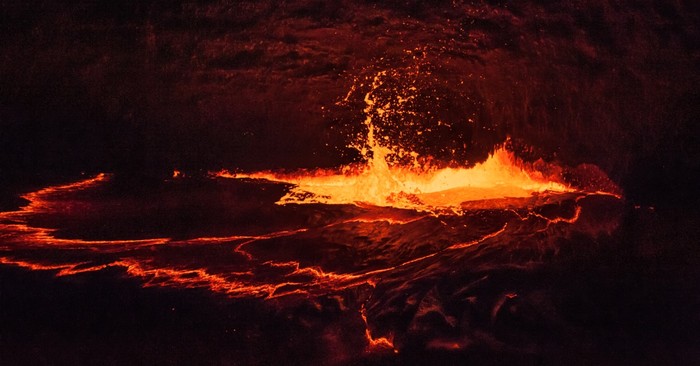Questions about Hell: Is It a Literal Fire? Or Worse?
- The Good Book Blog Talbot School of Theology at Biola University
- Updated Sep 20, 2021

Many mistaken ideas about hell have infected the church’s thinking, which further clutters our discourse about hell (such as: hell is a torture chamber where the devil and demons are tormenting humans, the devil rules in hell, hell is the absolute absence from God’s omnipresence, universalism, annihilationism, and purgatory).
Hell is a hard topic, and it’s hard to spend time thinking carefully about hard topics. Clearly, God wants us to think about it (and heaven), or else he would not have revealed it to us in so much description. What I set out here are three topics in the doctrine that may help resolve some of the difficulty we have in thinking about hell.
I. Metaphorical Language for Hell
The Bible uses vivid, horrible, and fearsome language in descriptions of the punishment people will suffer in hell. Prominent are statements about fire and burning, with the associated anguish and torment that we can imagine would go along with being burned continually.
I think it’s at least questionable if the descriptions of hell are not actual, but metaphorical. The imagery points to the reality, but not in a scientific reporting way we might expect of revelation on an important topic. Everyone knows what it is like to be burned with fire. Based on that memory of experiencing temporary hot pain, we can easily imagine the greater horror of being immersed in a lake of hot flame forever. With that pain in mind, I think the Bible leads us to conclude that hell is even worse than that. The terms given to us are from our experience to reveal further what we cannot be told in terms that we readily understand. Hell is not of this world.
I think there are three good reasons to take the descriptions of hell as metaphorical starting points revealing something much worse than the reality of actual flames and a lake of fire. This is not an air-conditioning of hell, as one prominent theologian has warned. This is to say that the revelation is figuratively accurate.
Metaphorical Names for Hell
The names for hell (Sheol, Hades, Tartarus, Gehenna, the second death) are all metaphorical. Sheol is the grave, a term that makes reference to ongoing existence of dead people by reference to the grave where their bodies remain. Hades is a name for the mythological location of the underworld, used in the NT to refer to the actual realm that is beyond this world of the living. Tartarus (only in 2 Peter 2:4), according to Greek mythology, is the place within Hades where the wicked suffer punishment. Tartarus is metaphorical for the actual punishment evildoers will suffer in God’s justice.
Gehenna is metaphorical reference to the actual place of punishment by using a term from the world of the living, the Hinnom Valley, where Israelites sacrificed their children in the detestable worship of Molech (just outside the city of Jerusalem). The reference of Gehenna is to shame, contempt, and pain in the netherworld, not merely to the Jerusalem garbage dump. Gehenna is used 13 times in the New Testament, usually translated as “hell.”
Finally, hell is identified as “the second death” in Revelation 20. By comparison with other ways death is used in the Bible, we can put this together as the loss and separation from all goods in this life irreversibly. Biological death is a separation of the spirit (or soul) from the body, and loss of ability to live on earth without the body. Spiritual death is clear in Ephesians 2:1-3 (”you were dead in the trespasses and sins”) as the loss of access to God and separation from the goods and freedoms that he alone provides. God warned of this consequence for sin in Genesis 2. Adam and Eve hid from God, blamed each other, and then were thrust out of the place of blessing, separated from the tree of life. Accordingly, hell as the second death is best understood as a permanent loss of opportunities and goods to be had from God because the evildoer is cast out and excluded from the kingdom of the new creation.
Metaphorical Descriptions of Hell
The descriptions of hell, if taken to be actual realities, seem to be incompatible with each other (fire, with its light, is together with darkness) and are obviously unreal (fire that does not stop, a worm that does not die). These point beyond themselves to worse things than being immersed in a lake of fire. Sulfur is mentioned to tell the high intensity of heat (as compared to low-heat from the flame of candle wax). The repeated ideas throughout the varied descriptions are pain, punishment, suffering, torment, and anguish. While I expect there is a significant physical aspect to the pain of hell, I expect that the internal burn is the worst part. (See my next post for this question.)
The fiery description of God’s punishments of evildoers in hell fits with the way that God is frequently described metaphorically in the Bible as “a consuming fire” and his anger is likened to heat and fire. Several times God does mete out punishment to people on earth by actually burning them (as with Sodom), but this is not the final punishment of hell to pay later. That people were burned to death by God was a sign to Israel that worse is to come for evildoers who do not repent, much like Jesus’ greater-than statements in Luke 13:1-6. He points to the death that some experienced by the hand of Pilate’s soldiers and by a falling tower as a sharp warning of worse peril to come.
Hell for Jesus and the Devil
We have the problem of being able to say that Jesus suffered hell at the cross, without flames, and that the devil, a spiritual being, will also suffer the punishment of hell’s flames. Neither can be true if we hold to descriptions as actual instead of metaphorical revelation of a horrible internal burn. The crucifixion certainly gives an external, physical pain. The three hours of unnatural darkness indicates something worse that brought his early death (hell was brought to him there, while on the cross). It seems best to think that the descriptions in all their horror point beyond the actual flame and sulfur to something worse that we can barely imagine: absolute banishment from God’s goods, unending suffering and anguish, and the certainty of no relief.
Related to these metaphorical descriptions of hell is the hyperbole Jesus uses to urge people to do everything necessary to avoid hell—even to the point of cutting off one’s hand or foot, or gouging out an eye. All these things are told so that we may flee hell while an opportunity of surrender to God remains open. We are urged to take hell as seriously as possible so that we may warn others of their impending peril should they not repent. This is not an acceptable message today, but that doesn’t make hell any less real or important for us to consider.
Photo credit: ©Getty Images/Brina Bunt
For more, visit the Good Book Blog, a seminary faculty blog from Talbot School of Theology.



















